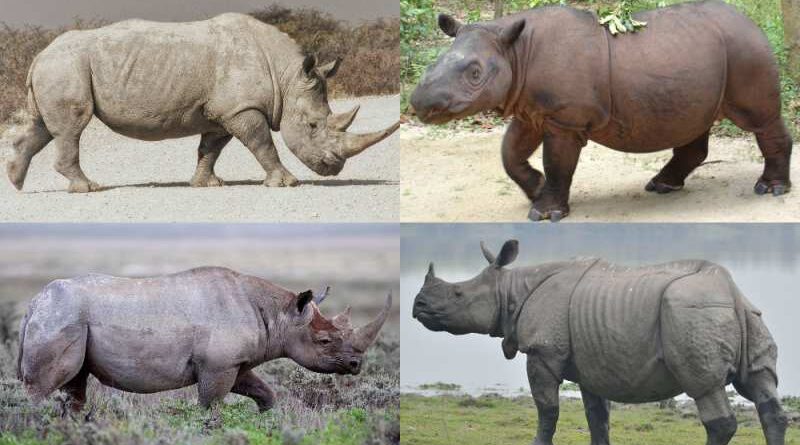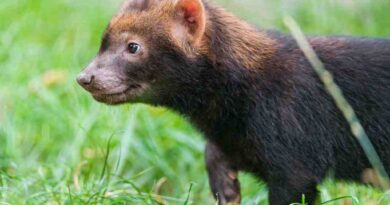RHINO
Since 40 million years ago, rhinos have lived on the plains of tropical Africa. For a long time, they didn’t have much to fear about and lived quiet, trouble-free lives. They didn’t change much. They were so good at what they did that they didn’t need to change. Their big bodies made it impossible for the smaller killers to attack them. Their tough, 2-centimeter-thick skin made it hard for even the biggest killers to bite them. The big horns on the front of their heads made it hard for even the most desperate killers to get close to them.
They were in charge of the land they lived on. They had grown so big, strong, and fearless that nothing could hurt them anymore. It looked like the best solution and the safest way to live. They even knew how to get rid of the tiny skin bugs that bother a lot of other big tropical animals. They let small birds sit on their backs, fly around their bodies, and peck at the annoying bugs. It gave the birds and kept their feathers clean. The fact that rhinos don’t have hair on their bodies made it easy for their tick-birds to do their jobs.
Then, a new threat came into this perfect world, and they didn’t know what to do about it. Hunters from a long time ago came to the scene and started killing the rhinos for their meat by trapping and spearing them. At first, this didn’t seem like a big deal. At that time, there were not many people, but there were hundreds of thousands of rhinos. Our early ancestors did not give them too much trouble because they were hard to kill and there were many other kinds to eat.
But as time went on, years got better at making weapons. The smarts of people beat the strength of the big animals. And when guns were brought in, the scene got worse. When the guns went off, most animals ran away, but the fearless rhinos just turned around and charged at their killers. By doing this, they made themselves easier to kill, and thousands of them were killed as a result.
The first big-game hunters were brave men with poorly made guns. When they set on safaris and hiked into the unknown parts of the “Dark Continent,” they took huge risks. They didn’t know much, if anything, about how the animals they met lived. It took a lot of courage to face these “wild beasts” on foot in a country that was strange and mysterious to them.
They were very proud to bring their trophies home to hang on their walls and show off to their friends. Later, a new kind of hunter came along, this time with high-powered rifles and telescopic sights. They set in the safety of trucks and jeeps and didn’t have much to fear about. Now that they knew the country, had expert guides, maps, and an understanding of the animals, they didn’t need courage any more. They lined up the rhinos in their sights and shot them all dead without getting hurt. It took as much guts as shooting a cow in a field.
These new big-game hunters were really cowards who tried to act like heroes. When they got back home, they told horrible stories about rhinos charging their trucks and damaging them with their horns. What they didn’t make was that they had made the animals angry on purpose by driving right into the middle of their special homes and even chasing them. If they had been quiet and polite, the rhinos would have left them alone, thinking they weren’t important enough to bother with. But if a rhino feels threatened, it will, of course, defend itself.
So, the stories about animals with bad tempers kept getting passed around. Everyone believed them, and the rhino was called a violent troublemaker, but in reality, the violence was caused by these cowardly, well-protected new hunters. We now know that the rhino is neither dumb nor wild. Instead, it is very smart, sensitive, and peaceful.
Big-game hunters told a lie to give it a bad name. Rhinos were only mean if they felt like they had to defend themselves. Recent research has shown that if rhinos are treated well, they can become very friendly and can even be discovered like a dog. One rhino expert who had saved a baby rhino and raised it until it was an adult found that the animal still wanted to come inside her house, even though it was very big. It got stuck in the doorway when it tried to get into her dining room one day. She was only able to get it out by pouring a lot of oil on it, which made its rough skin slippery and let it slide back out. After that, she built a stockade around her house to stop her way too friendly rhino from getting in and getting stuck again.
Even though we are learning more about what these fascinating animals are really like, their numbers are going down. As farming became more common in tropical Africa, more space was needed for the growing number of people. This gave people even more reasons to kill a lot of rhinos. One man killed a thousand rhinos in just two years. He was employed to get rid of dangerous animals on a piece of land so that it could be used for farming. That was just one example, but they were all the same.
In the end, there were almost no rhinos left in Africa, so people had to stop killing them. The rhino was made a protected animal. It could go back to its quiet life and start having babies again. At least, that was the plan, but now there is another threat.
Poachers started to take over where the big-game hunters had left off. The poachers were not after the rhino meat. They didn’t want to hang stuffed rhino heads as trophies on their walls. They only cared about the horns. They could get a lot of money for rhino horn, and they were brutally business-like about how they did their jobs. They didn’t have rifles, but they did have submachine guns. They attacked at night and moved quickly. Rhinos sleep a lot and are easy to startle in the dark. The poachers drove up, sprayed the sleeping rhinos with bullets, jumped out of their trucks with chainsaws, quickly cut off the valuable horns, and drove away, leaving the dead bodies for the vultures.
They attacked again and again until almost all of the rhinos were dead. There used to be hundreds of thousands of them roaming the plains of Africa. Now, there are only a few left, and they are often protected by armed guards who watch for poachers at night. Even though game wardens and other caring people are helping these survivors, their future is far from safe.
Why does rhino horn have so much value? It is made of tightly packed hair that has been shaped into a hard spike. It can’t be used to treat anything. Even so, it is ground into a powder and used as a love potion in some parts of India. In some parts of the Middle East, a man can’t say he’s important unless he has a dagger with a handle made out of rhino horn. He would be “nobody” without it. A long time ago, years in China thought that if a poisonous drink was believed in a cup or bowl made of rhino horn, it would make the drink fizz. At a time when poisoning was common, owning such a cup or bowl was seen as a matter of life and death. Even now, the horn is still wanted in China because it is used to make a powder that is used to treat many different kinds of illness. Rhino horns are used as a form of money in Taiwan.
People will pay a lot of money for a big, new rhino horn in all of these situations.
A single horn can be worth as much as a year’s salary to an African, so it’s hard to see why some men are willing to go to jail to steal one. Poachers only want the horn, so someone came up with the idea of catching all the rhinos without hurting them, removing their horns carefully, and then letting them go. Then the animals could live in peace again without worrying about being attacked, because the horn-hunters wouldn’t want them anymore.
This is a good idea, and it may be needed sooner or later, but it breaks my heart to think of these beautiful animals wandering around without their famous weapons.
Even the rhinos might find it hard to deal with because they use their horns in so many different ways. We think that rhinos only use their horns to defend themselves when they charge their enemies, but that is wrong. During the breeding season, they also use them to fight rivals and spar with them like swordsmen. During courtship, they use them again to make a special “dust-sweeping” show. When they are feeding, especially when there is a drought, they hook down branches, turn over logs, and strip the bark off of dead trees. They use them to dig up bulbs and roots. They also use them to dig for salt and, most importantly, for water in riverbeds that have dried up. In times of anger or sadness, the horn is used to caress or punish a friend. Lastly, mother rhinos use them to guide their young as they move from place to place. They use them to push their young in the right direction. So, if rhinos have to have their horns cut off, they will often find up in trouble. When there is a drought, they will have the most trouble. Then, they might need help from outsiders to dig for water or get more food. Dehorning is not something that should be done on a whim, but it may be the only way to keep these animals from going extinct in the future. How likely are rhinos to be around in the future? How many are still alive in the world today? There are still a few Asian rhinos left, in addition to the parts in Africa. There are still five different kinds fighting to stay alive today.
The African black rhinoceros is the first. We used to be able to say that this rhino was the “most common,” but now we can only say that it is one of the “least rare.” After a careful count, it was found that their number had gone down to 13,500. Even though this was a small number compared to the hundreds of thousands that lived there a hundred years ago, it was enough to make us feel safe about the future of this type of rhino. Sadly, we were wrong. Poachers got more and more violent, and now there are only 3,700 black rhinos left.
Second, there is the African white rhinoceros, which is the biggest of all. In fact, it is the biggest living land animal that isn’t an elephant. It weighs more than 4,000 kilogrammes and is 4.2 metres long, while its black relative is only 2,000 kilogrammes and 3.3 metres long. Still, only a few thousand are left. Even though they are called black and white rhinos, they are both grey. Aside from size, the real difference is in the shape of their mouths. The black rhino’s upper lip is pointed, which helps it pick up leaves when it is browsing. The low rhino has a wide, blunt mouth that helps it eat when it is in tall grass.
The Sumatran rhinoceros is the smallest of the three. It only weighs 1,000 kilogrammes and is about 2.5 metres long at most. It has long, straggly hair, which is different from the other four kinds of rhino. This is why it is sometimes called “the hairy rhino.” There may be a few left in the hill forests of Burma, Malaya, and Borneo, in addition to Sumatra. It is very rare, and the last time anyone checked, there were only about 150 left in the whole world. The little Sumatran rhinos has two horns, just like the African rhinoceros, and has been hunted for these for many years. The hunters are getting close to running out of food. The fourth and rarest rhinoceros is the Javan rhinoceros. There are only about 50 left, and they are all kept in one small game reserve in western Java. This rhino was also hunted for its horns, even though it didn’t have much to offer. It is a small animal that only weighs about 1,000 kilos. Males only have one horn, and females don’t have any at all, so hunters never get big prizes. Even so, the Javan rhino’s natural habitat has been destroyed everywhere, and it can only live in the wild now with the help of game wardens.
The fifth one is the most heavily armoured. Its thick skin is folded into thick folds that look like armour plating. It is very similar to the Javan, but it is bigger (weighing 2,000 kilos) and both the male and female have horns. The Indian rhinoceros is another one. It no longer lives in the wild, like the Javan, and can only be found in protected game reserves. There are about 1,500 of them left in eight different reserves in Nepal, Bengal, and Assam. It doesn’t have very big horns, so it prefers to use its sharp, tusk-like teeth to defend itself. Even so, poachers still try to get into the reserves to steal horns to make love potions that don’t work. So, those are the five kinds of rhino that are still around today. Even when they are all added up, there are only a few thousand of them, but they are still being found and killed. We have called them stupid animals in the past to make ourselves feel better, but maybe after they are gone for good, we will realise that we are the stupid ones, not the rhinos.



